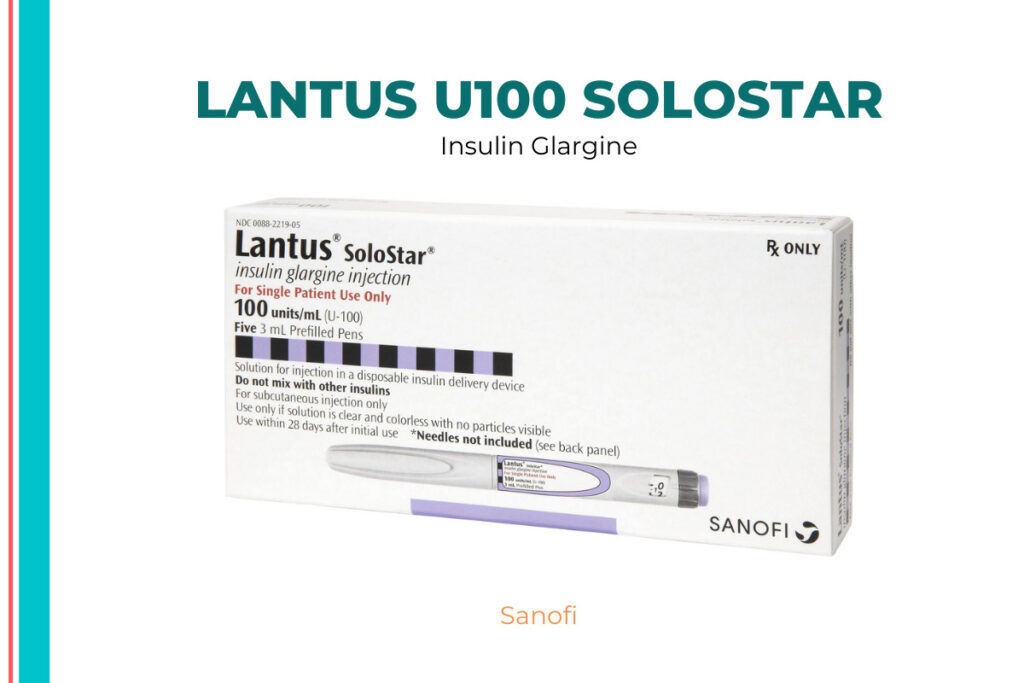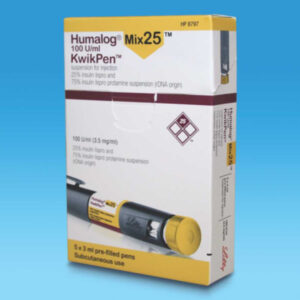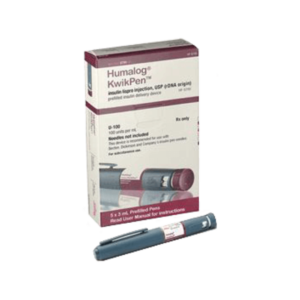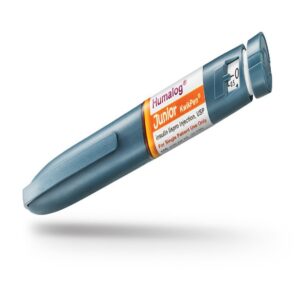Lantus 100IU/ml Injection 10 ml
Lantus 100IU/ml Injection 10 ml includes insulin glargine and is a long-acting insulin. This is a modified insulin that looks and acts very much like human insulin. Human insulin is a brand name for synthetic (human-made) insulin that is generated in a lab to replicate human insulin. Adults, adolescents, and children aged 2 years and up are prescribed Lantus 100IU/ml Injection 10 ml to treat diabetes mellitus. Diabetes mellitus is a condition in which your body does not create enough insulin to keep blood sugar levels under control. Lantus 100IU/ml Injection 10 ml lowers blood sugar levels for a long time. Long-acting insulin takes about 2 hours to begin operating, and it’s designed to act evenly so there’s no such thing as a peak activity. Long-acting insulin can last for up to 24 hours. Treatment with Lantus 100IU/ml Injection 10 ml can help you avoid diabetes problems. To treat diabetic ketoacidosis, do not use Lantus 100IU/ml Injection 10 ml (too much of acids in the blood).
Injection of Lantus 100IU/ml 10 ml insulin is a long-acting insulin that keeps blood sugar levels stable. As a result, it aids in the reduction of blood sugar levels throughout the day. Based on your lifestyle, blood sugar (glucose) test results, and previous insulin usage. Your doctor will tell you how much Lantus 100IU/ml Injection 10 ml you’ll need each day and when you should take it.
It may be prescribed by your doctor in conjunction with a short-acting insulin or oral anti-diabetics to treat high blood sugar levels. Your blood sugar level can be affected by a variety of variables. These aspects should be understood so that you can react appropriately to variations in your blood sugar level and avoid it being too high or too low.
In some circumstances, injection site reactions such as tumors under the skin may occur. To avoid skin abnormalities such as lumps under the skin, the injection site should be rotated. Sweating, clammy skin, nervousness, and a fast heartbeat are all indications of hypoglycemia (low blood sugar). The majority of these Lantus 100IU/ml Injection 10 ml adverse effects do not require medical treatment and fade away with time. However, if the negative effects do not go away, consult your doctor.
Try not to stop injecting yourself with Lantus 100IU/ml Injection 10 ml. It’s important to tell your doctor about this because it could create withdrawal symptoms. If you have low blood glucose levels, kidney, liver, or heart problems, or difficulties with alcohol or other prescription recreational drugs, do not use Lantus 100IU/ml Injection 10 ml. Along with Lantus 100IU/ml Injection 10 ml, you should eat a balanced diet, exercise regularly, and keep your weight under control as directed by your doctor. Lantus 100IU/ml Injection 10 ml is a cold chain medicine that must be kept in the refrigerator between 2 and 8 degrees Celsius to maintain its efficacy. Do not store in the refrigerator’s freezer.
Lantus 100IU/ml Injection 10 ml uses
Type 1 diabetes, Type 2 diabetes, Type 3 diabetes, Type 4 diabetes, Type 5 diabetes, Type 6 diabetes, Type 7 diabetes, Type 8 diabetes, Type 9 diabetes

Medicinal Advantages
Lantus 100IU/ml Injection 10 ml lowers blood sugar levels for a long time. Long-acting insulin takes around 2 hours to start working, and it’s meant to work in a consistent manner without causing a spike in activity. Long-acting insulin can last for up to 24 hours. This insulin encourages body tissues to absorb glucose from the blood and reduces the amount of glucose produced by the liver. Lantus 100IU/ml Injection 10 ml improves glycemic control, lowering the likelihood of developing diabetes complications such as retinopathy, nephropathy, nerve cell damage (neuropathy), delayed wound healing, diabetic foot ulcer, and others. Lantus 100IU/ml Injection 10 ml, on the other hand, can be safely recommended to diabetic mothers during pregnancy and lactation.
Use Instructions
Injection of Lantus 100IU/ml A total of 10 ml is injected beneath the skin (subcutaneously). Lantus 100IU/ml Injection 10 ml should not be injected into a vein. Every day, at the same time, you must inject one dose of Lantus 100IU/ml Injection 10 ml. If you are not confident in your ability to self-administer Lantus 100IU/ml Injection 10 ml, have it administered by a healthcare expert. Insulin self-injection procedure: Before injecting insulin, you should cleanse your hands. After that, roll the insulin bottle and wipe the top. Pull the syringe plunger all the way down to the number of units your doctor has prescribed. Push the syringe plunger down and the needle into the bottle. Pull the plunger down to the proper number of units as directed by the doctor once again. Take an alcohol swab and wipe the injection site. Pinch up the skin, insert the needle, and then press the plunger into the skin. To ensure that the complete dose is injected, keep the needle under the skin for at least 6 seconds. Remove the needle and dispose of the syringe carefully after injecting the insulin. After that, you can eat or snack.
Store in a cool, dry location away from direct sunlight.
Lantus 100IU/ml Injection 10 ml Side Effects
Lantus 100IU/ml Injection 10 ml, like all drugs, can produce side effects, though not everyone experiences them. Cold perspiration, cool pale skin, uneasiness, worried feelings, unusual tiredness or weakness, confusion, difficulty concentrating, drowsiness, excessive hunger, transitory vision changes, headache, nausea, and rapid pulse or heartbeat are all signs of low blood sugar or hypoglycemia (palpitation). Reddening, particularly acute pain when injecting, itching, hives, swelling, or inflammation are all signs of skin and allergic reactions at the injection site. This has the potential to extend beyond the injection location. Most modest insulin responses go away within a few days to a few weeks. If you experience symptoms of a severe allergic reaction, call your doctor right once. The above side effects are not required for everyone.
Drug Recommendations
Insulin Glargine should only be used subcutaneously (under the skin) and should never be given intravenously (IV) or through the veins. If you’re switching insulin brands or need to inject your insulin in a different way, you should do it under medical supervision. When pioglitazone was combined with insulin, cases of heart failure were documented, particularly in patients who were at high risk of cardiac heart failure. Excessive thirst, dry mouth, increased frequency of urination, nausea, vomiting, drowsiness, flushed dry skin, loss of appetite, and acetone odor of the breath are some of the early symptoms of hyperglycemia (high blood sugar level). You should keep a watchful eye on these signs. Heart failure, weight gain, and oedema (fluid accumulation in tissue) are all symptoms that should not be ignored. It is best not to drink alcohol because it might either raise or lower your blood glucose level. When traveling over more than two time zones, extreme caution is advised. Your insulin schedule may need to be adjusted by your doctor. Insulin Glargine can lower potassium levels, resulting in hypokalemia, which can lead to respiratory paralysis, abnormal cardiac rhythm, coma, and even death if left untreated. If you have low blood glucose, kidney, liver, or heart problems, or if you have difficulties with alcohol or other prescription recreational drugs, don’t take Insulin Glargine.
Interactions Between Drugs
Interactions between drugs: Antidepressants (lithium, fluoxetine), pain relievers (aspirin, pentoxifylline, propoxyphene), anti-TB drugs (isoniazid), growth hormone (somatropin), thyroid hormone-related drugs (levothyroxine), antipsychotic medicines (phenothiazine, clozapine, olanzapine), anti-cholesterol drugs (fenofibrate), antipsychotic medicines (phenothiazin
Insulin Glargine may interact with ayurveda, homoeopathic, homeopathy, herbal supplements, or over-the-counter medications. If you’re utilizing any of these products, let your doctor know. Avoid drinking alcoholic drinks while taking Insulin Glargine because it may cause your blood sugar level to spike or fall.
Insulin Glargine should not be given to people who have kidney illness, liver disease, low blood sugar or glucose (hypoglycemia), or low potassium levels (hypokalemia).
Safety Suggestions
ALCOHOL
To avoid unpleasant side effects, you should not drink alcohol while taking Insulin Glargine. Alcohol can either lower or raise blood sugar levels, which can be deadly.
PREGNANCY
Glargine insulin is safe to take throughout pregnancy. During pregnancy and after delivery, your insulin dose may need to be adjusted. Before using Insulin Glargine, talk to your doctor.
BREAST FEEDING
Glargine insulin can be safely given to nursing moms, but only under the care of a doctor. Your insulin levels and diet may need to be adjusted by your doctor.
DRIVING
Drive carefully since Insulin Glargine often induces drowsiness and impairs driving abilities. If you have hypoglycemia, your ability to concentrate and react may be impaired (low blood sugar).
If you have a history of liver disease or condition, LIVER Insulin Glargine should be used with caution. Your doctor may need to modify the dosage.
KIDNEY
If you have a history of renal disease or condition, Insulin Glargine should be used with caution. Your doctor may need to modify the dosage.
No habit formation
Advice on Diet and Lifestyle
Exercise can reduce your body’s need for insulin while you’re doing it and for a while afterward.
Exercise can also hasten the effect of an insulin dose, particularly if it includes the injection site (for example, the leg should not be used for injection just prior to running).
Discuss how you should change your insulin plan to accommodate exercise with your doctor.
Sugary foods should be avoided, and prepared, low-calorie foods should be preferred.
If you’ll be traveling across more than two time zones, consult your doctor about making adjustments to your insulin plan.
Recommendations
To lessen the risk of lipodystrophy (pitted or thicker skin) and localized cutaneous amyloidosis (skin with lumps) at the injection sites, change (rotate) your injection sites within the area you chose with each dose. If the skin is pitted, thickened, lumpy, painful, bruised, scaly, hard, scarred, or injured, do not utilize the same place for each injection.
Other details: This item is non-refundable.
Concerns of Patients
Type 1 diabetes mellitus is a condition in which our bodies do not produce enough insulin (a hormone that helps to lower blood sugar levels) to keep blood sugar levels under control.
Type 2 diabetes mellitus occurs when the body either stops producing adequate insulin or when the body’s response to insulin is resistant. As a result, sufficient amounts of insulin are created, yet it is unable to function on organ tissues.
FAQs
Insulin Glargine should not be injected into veins or administered intravenously (IV). It should only be used in the subcutaneous area beneath the skin. The ideal place for injecting Insulin Glargine is the abdomen (stomach). Insulin Glargine can also be injected into the upper arm or thigh region.
Insulin Glargine is a kind of insulin that can be used to treat both type 1 and type 2 diabetes. However, depending on your current state, your doctor will determine if Insulin Glargine can be given to you or not. Patients who are allergic to Insulin Glargine or other types of insulin should avoid using it. Patients with low potassium levels (hypokalemia), moderate to severe kidney illness, or liver disease should avoid it. If you are pregnant or breastfeeding, tell your doctor.
Insulin glargine is the active ingredient. The solution contains 100 units of insulin glargine per milliliter (equivalent to 3.64 mg).
Insulin Glargine lowers blood sugar for a long time and in a consistent manner. Long-acting insulin takes around 2 hours to start working and is meant to work in a consistent manner, with no peaks in activity. Long-acting insulin can last for up to 24 hours.
Insulin Glargine is a cold chain drug that must be stored at 2-8 degrees Celsius or its effectiveness in lowering blood glucose levels may deteriorate. Keep it out of the freezer.
Type-2 diabetes does not usually afflict healthy children and teenagers, however it can impact fat youngsters, often known as Childhood Obesity.
Insulin Glargine is typically considered safe to consume for an extended period of time. In fact, it is most effective when taken for several months or even years.







Leave a Reply
You must be logged in to post a comment.